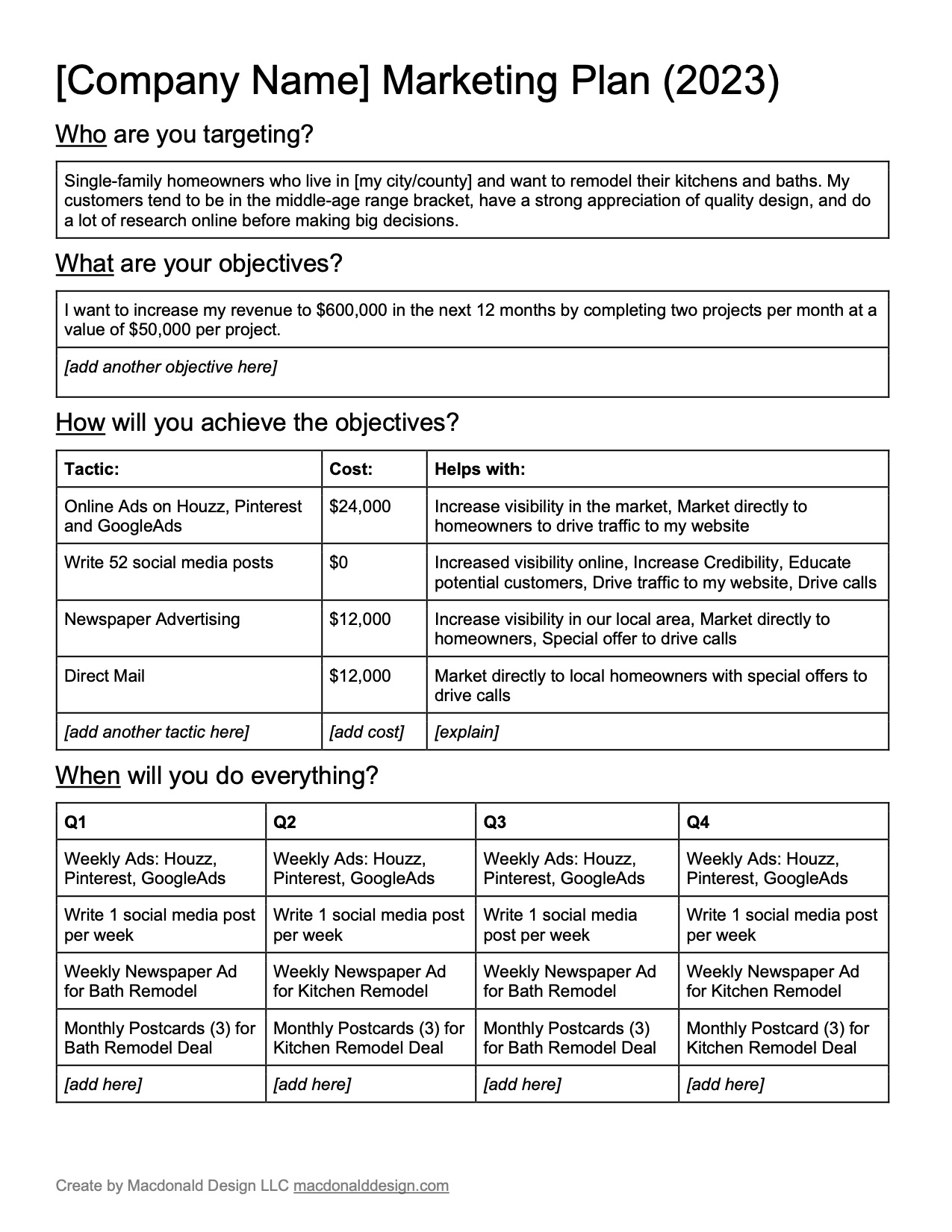afresh: Local Marketing Essentials in the Digital Age – Part 2: Your Marketing Plan

Part 2: Your Marketing Plan
In our first article, we took a broad-strokes approach to the general strategy for your small business marketing. We kept it relatively loose and subjective, casting a wide net for brainstorming ideas and creative potentials. Now we’ll show you how to take all of those great ideas and convert them into a formal marketing plan.
Your marketing plan needn’t be long or complicated. In fact, we recommend keeping it short and simple! Your plan should answer these questions:
- Who are you targeting?
- What are your objectives?
- Where will you reach your customers?
- How will you achieve your objectives?
- When will you take action?
Why build a plan?
First, let’s start with why you should even build a marketing plan. A plan will help you to clarify the next steps to take. It will help you to be efficient with your time and resources. And it will help you hold yourself accountable for the work that needs to be done, whether you do the work yourself or delegate it to others.
Think of your marketing plan as a “living” document that lays out the step-by-step actions you will take to achieve your goals. By “living,” we mean that a marketing plan is never truly final. It is always going to be a work-in-progress, updated over time, as you try out new approaches and learn what works and what doesn’t work for your target market.
The adage, “Perfection is the enemy of done” holds true for marketing plans. And so does the concept of analysis paralysis. It is very common for people to get so caught up in the details of what could be and spend time exploring every possible option, that they never actually get anything done! In other words, don’t spend too much time on your plan. Save plenty of time for execution.
As you write your marketing plan, be as specific as possible. Use financial metrics, specific numbers, and specific time frames to define your tasks and goals. Let’s take it one step at a time:
Who are you targeting?
 In one sentence, write down who your ideal customer is. It’s okay to be niche-oriented. In fact, it’s a very effective way to market. For example, “I’m targeting [_____] who live in [your specific towns/neighborhoods] and want [______]. Include details about your customers’ psychographics, demographics, and buyer behavior here, if relevant.
In one sentence, write down who your ideal customer is. It’s okay to be niche-oriented. In fact, it’s a very effective way to market. For example, “I’m targeting [_____] who live in [your specific towns/neighborhoods] and want [______]. Include details about your customers’ psychographics, demographics, and buyer behavior here, if relevant.
If you have multiple customer types or segments, write a sentence for each of your most common customer profiles, limiting yourself to three. Then rank them. Put the most profitable customer segment at the top!
For example, as a builder, you might say, “I’m targeting single-family homeowners who live in Santa Cruz and want to remodel their kitchens and baths. My customers tend to be in the middle-age range bracket, have a strong appreciation of quality design, and do a lot of research online before making big decisions.”
What are your objectives?
Now that you have defined who you’re targeting, let’s define what you want them to do and how it will impact your company. Pick a few very specific, actionable, and realistic goals or results, that you want to achieve. For example, “I want to increase revenue to [x amount of dollars] in the next [timeframe] by signing up [x more customers].” Or, “I want to grow my brand awareness in the local market in the next [timeframe], resulting in increased foot traffic to my store by [x number of people] per week,” or “I want to sign up [x more clients] for monthly retainer services.”
Note how each of these goals uses quantifiable numbers and metrics that can be measured. Another term for these goals is key performance indicators (KPIs). The reason it’s important to use specific metrics is that what gets measured gets managed.
Going back to our example of the builder, you might say, “I want to increase my revenue to $600,000 in the next 12 months by completing two projects per month at a value of $50,000 per project.”
What is your irresistible offer or key messaging?
 Your irresistible offer will drive your success, by driving your target customers to your desired outcomes. Every prospective customer wants to know, “What’s in it for me?” You have to answer that question for them, so they don’t have to think too hard about it. The offer should be so compelling, so enticing, and so exciting, that it drives them to action—with urgency!
Your irresistible offer will drive your success, by driving your target customers to your desired outcomes. Every prospective customer wants to know, “What’s in it for me?” You have to answer that question for them, so they don’t have to think too hard about it. The offer should be so compelling, so enticing, and so exciting, that it drives them to action—with urgency!
This is where your knowledge of your customer comes in. You know what they want—whether it’s value, convenience, selection, something custom, or something that makes them feel a certain way. It’s unique to each business. Pick the right words to describe it. This is your positioning, what differentiates you from the rest. It’s your offer or offering. It’s also called your “unique selling proposition” (USP).
Write one to three sentences describing your offering, the first sentence being the most important message you want to get across. Your messaging should easily answer this question in your customer’s mind: “What’s in it for me?”
For our builder business example, your message might say, “Award-winning custom remodeler will bring your vision to life with professionalism, reliability, and expert craftsmanship. Join our long list of happy clients.” Your irresistible offer might follow, saying, “Schedule your quote consultation before the 30th of this month, and receive a $2,500 credit that can be used on any 2023 remodeling project.”
Where and how will you achieve your objectives?
Now that you have your messaging down, you need to determine the channels you will use to communicate it to your prospects. Marketing channels can be traditional, such as newspaper ads, radio, and direct mail, or they can be digital, such as keyword advertising, social media, and email, to name a few. And don’t forget about direct sales, networking, and public relations (PR). Based on what you know about your customers, make a list of all the channels you will try.
 In addition to the channels, determine your marketing budget. For each channel in your list, allocate a dollar amount to spend in that channel. One way to decide how much to spend is to use a percentage of revenue approach. If you’ve been in business for years and have millions of dollars in sales, 2% to 3% of revenue on marketing is pretty typical. But, if you’re a small business with less than $5 million in revenue, you should allocate 7% to 8% of revenue to marketing. This is a general rule of thumb that’s referenced in Inc. magazine’s article, “Budgeting for Advertising and PR for a Small Company.”
In addition to the channels, determine your marketing budget. For each channel in your list, allocate a dollar amount to spend in that channel. One way to decide how much to spend is to use a percentage of revenue approach. If you’ve been in business for years and have millions of dollars in sales, 2% to 3% of revenue on marketing is pretty typical. But, if you’re a small business with less than $5 million in revenue, you should allocate 7% to 8% of revenue to marketing. This is a general rule of thumb that’s referenced in Inc. magazine’s article, “Budgeting for Advertising and PR for a Small Company.”
Marketing spending also varies by industry. Retail businesses, for instance, spend a higher percentage of revenue on marketing than other types of businesses. Try to find out what other companies in your industry spend on marketing by reading industry publications, studying research reports, and attending industry events. These are your industry benchmarks.
Another factor to consider when deciding your budget is what stage of growth your business is in. If you have a new business, you’ll want to base your marketing budget on your projected or forecasted revenue. And, if you’re trying to quickly capture market share, that’s another reason to increase your budget. Some marketing channels cost more than other channels, and certain geographic areas or target markets cost more to reach than others, so call around and get quotes to inform your budgeting decisions.
When selecting your channels, consider tailoring your offering to each channel. For example, in a newspaper ad you might provide a coupon for a special deal, whereas in an email blast, your objective might be to deliver valuable content that presents you as a thought leader. So the call-to-action (CTA) might be to get a prospect to sign up for a webinar. Write out how each channel’s spending will contribute to your overall objectives.
For example, let’s go back to the growth-oriented builder in our example, shooting for $50,000 a month in revenue. If the company allocates 8% ($4,000) to marketing per month, it might put $2,000 into online media advertising across channels such as Houzz, Pinterest, and Google keyword ads, and $2,000 into traditional marketing channels such as newspapers or direct mail campaigns.
When will you do things?
The last step is to plan out when each task will be done. This can take the form of a Gannt chart, grid, list, or calendar. We suggest using quarterly time brackets, but you can break tasks down by month, by week, and even by day. If content marketing is part of your plan, create a content calendar that outlines when you will write and post about specific topics. To quickly organize your plan, download our Marketing Plan Template ( 20kB ) and get started!
As you plan, be specific and use numbers. For instance, “First Quarter: Write six social media posts (two per month) and post each of them to three social media platforms: Facebook, Instagram, and Twitter.” This is how you will track your progress and ultimately your success.
In our example business, the plan might read, “First Quarter: Set up business profiles on Houzz and Pinterest. Post portfolio work and set up sponsored listings. Set up a GoogleAds account and write half a dozen ads to try out. Send copy/images to local papers and printers, run newspaper ads every other week, and one direct mail postcard campaign before the end of the quarter.”
By following these simple steps, you will be doing all the right things to move your business forward. Now that you’ve made a plan, it’s all about the follow-through. In our next article (coming soon), we’ll focus on how to execute the plan you’ve created and see it through.
Do you want expert guidance with your marketing plan?
Call, chat, or email us if you want help with your marketing plan.
Fill out our callback form and we’ll call you back quickly!
Request a Callback
Let us help you achieve your marketing goals. Request a callback now!

